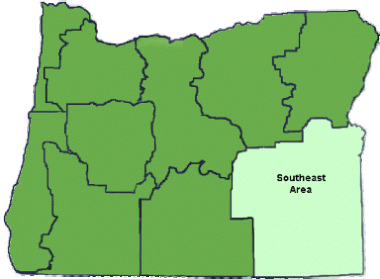
Warmwater fishing in southeast Oregon
The southeast area covers the high desert country of Harney and Malheur counties and is the most arid region of Oregon. Extended dry periods or droughts can affect the warmwater fisheries in this area, but these can be quick to rebound when water returns. The area’s most popular warmwater fishery is found in Owyhee Reservoir, a huge nearly 14,000 acre reservoir located on the Owyhee River south of Ontario that offers outstanding fishing for bass, crappie and catfish. There are few roads to and along Owyhee, but those with a boat will be rewarded with remote and spectacular scenery. Other good waters for bass, crappie and catfish include Warm Springs Reservoir on the Malheur River east of Burns and Bully Creek Reservoir still further east near Ontario.

The southeast area supports a surprising variety of warmwater fish including: Largemouth Bass | Smallmouth Bass | Bullheads | Black Crappie | White Crappie | Bluegill | Pumpkinseed | Yellow Perch | Warmouth | Channel Catfish |
Featured waterbody - Owyhee Reservoir
Owyhee is a 53-mile long reservoir on the Owyhee River about 40 miles southwest of Ontario in the desert canyons of far eastern Oregon. Owyhee Lake Road leads to Owyhee Dam and the campgrounds at Lake Owyhee State Park on the lower (north) end of the reservoir. Otherwise, only a handful of remote and rough roads, including Leslie Gulch, provide additional access. In Oregon’s largest reservoir, the best fishing is from a boat and there are four boat ramps at the northern end within a few miles of the dam. There is a fifth ramp near the southern end at Leslie Gulch, but the gravel access road can get sloppy if the weather has been wet so check ahead for conditions. Fuel and groceries can be purchased at the State Park. You’ll even find a floating restroom located about seven miles up the reservoir.
Water levels in Owyhee Reservoir can fluctuate dramatically during the year so be sure to check on current levels and availability of boat ramps. The general consensus among anglers is that the water needs to be up and stable for a couple of weeks for the best fishing. For current information about boat ramp access, go to the Bureau of Reclamation website.
Owyhee Reservoir offers an outstanding warmwater fishery for several species of fish including largemouth and smallmouth bass, crappie, channel catfish and yellow perch. You might also catch an occasional redband trout.
When to fish
Bass and crappie are the most sought after fish in Owyhee. Bass fishing is good from early spring through late fall, although anglers should check with the Bureau of Reclamation in late summer to see if water levels in the reservoir will limit access. April through June provides the best time to fish for crappie. The best fishing is in the mornings and late evenings..
Where to find bass
In the spring, bass prefer shallow waters near submerged brush, weeds and trees. As the water temperatures rise and the water levels drop during the summer, bass will move to deeper water and near rock structures and points of land. The best places to fish for largemouth bass are the coves near the Elbow, both sides of the reservoir near the airport, and in the upper reservoir near the Hot Springs. Smallmouth bass are found throughout the reservoir, but are most abundant below the Dry Creek arm (particularly in the forebay of the dam) and above Leslie Gulch.
Where to find crappie
In the spring, crappie will be along the shoreline and at the ends of coves near submerged brush and other cover. Although crappie are easy to catch from shore near the dam, they are also abundant in the larger coves between Dry /Cherry Creeks and Leslie Gulch. In the spring, as the spawning season nears, crappie will move inshore to water 5- to 20-feet deep and will travel from just under the surface to just off the bottom. As the water warms after spawning, crappie will move farther offshore to waters 15- to 30-feet deep and will look for cover near larger submerged rock structures. The best area for finding crappie is near the dam.
Where to find catfish
Catfish are most abundant in the upper reaches of the reservoir from Doe Island upstream to the river.
Techniques for bass
Cast and retrieve for bass. Use medium to heavy bait casting or spinning tackle rigged with 8- to 12-pound test line. Early in the season before bass have spawned, fish with a jig, a tube, or black or purple rubber worms. A deep, slow presentation is key. Post-spawn bass are taken with bigger and faster presentations using lures such as crankbaits and white spinnerbaits.
Techniquesfor crappie
Still fish for crappie. Use a light action rod and 4- to 6-pound test line to fish a bobber and jig. Use crappie jigs and plastics with light-color bodies and darker-color heads. Mini-tubes and mini-grubs also work well.
Techniques for catfish
Most standard gear works well for catfish, such as a 5- to 7-foot casting or spinning rod and 4- to 8-pound test line rigged with a slip-sinker and bait. Tie a 12- to 18-inch leader below the swivel and attach a hook baited with worms or other panfish or catfish bait. Baits with a strong odor work best for catfish. The sliding sinker allows fish to take the bait before feeling the weight of the sinker.



